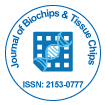Make the best use of Scientific Research and information from our 700+ peer reviewed, Open Access Journals that operates with the help of 50,000+ Editorial Board Members and esteemed reviewers and 1000+ Scientific associations in Medical, Clinical, Pharmaceutical, Engineering, Technology and Management Fields.
Meet Inspiring Speakers and Experts at our 3000+ Global Conferenceseries Events with over 600+ Conferences, 1200+ Symposiums and 1200+ Workshops on Medical, Pharma, Engineering, Science, Technology and Business
Editorial Open Access
Biochips and Tissue Chips-Integrating Biologists, Physicist, Chemist and Material Scientists
| Hui-Fen Wu1,2,3* | |
| 1Department of Chemistry, National Sun Yat-Sen University, Kaohsiung, 70, Lien-Hai Road, Kaohsiung, 80424, Taiwan | |
| 2Center for Nanoscience and Nanotechnology, National Sun Yat-Sen University, Kaohsiung, 70, Lien-Hai Road, 80424, Taiwan | |
| 3Doctoral Degree Program in Marine Biotechnology, National Sun Yat - Sen University, Kaohsiung, 70, Lien-Hai Road, 80424, Taiwan | |
| Corresponding Author : | Hui Fen Wu Department of Chemistry Center for Nanoscience and Nanotechnology and Doctoral Degree Program in Marine Biotechnology National Sun Yat-Sen University Kaohsiung, 70, Lien-Hai Road Kaohsiung, 80424, Taiwan Tel: +886-7-5252000-3955 Fax: +886-7-5253908 E-mail: hwu@faculty.nsysu.edu.tw |
| Received February 10, 2012; Accepted February 13, 2012; Published February 15, 2012 | |
| Citation: Wu HF (2012) Dental Cell Biology, Biochips and Open Access. J Biochip Tissue chip 2:e106. doi:10.4172/2153-0777.1000e106 | |
| Copyright: © 2012 Wu HF. This is an open-access article distributed under the terms of the Creative Commons Attribution License, which permits unrestricted use, distribution, and reproduction in any medium, provided the original author and source are credited. | |
Visit for more related articles at Journal of Bioengineering and Bioelectronics
| Dear readers of the Journal of Biochips and Tissue chips, |
| We are pleased to introduce you to this Journal published by one of the most renowned publishers, the OMICS Group. The OMICS Group is rather unique in that they have adopted the open access initiative. Abstracts and full texts (HTML, XML and PDF format) of all articles published by OMICS Group are freely accessible to everyone immediately after publication. The impact such an initiative has on the dissemination of scientific knowledge is immense and will continue to abound in leaps and bounds. This would also have a direct impact on those who decide to publish with the OMICS Group Journals, since the citations and recognition of their research is likely to benefit largely from the open access initiative. |
| The introduction of this Journal with this dedicated scope, relating to interdisciplinary areas of materials science and biology/microbiology boosts the value of this journal. The current trend in the research arena envelops the blending of cross field research and most of all the incorporation of biology into main streams such as physics, chemistry and engineering. Most of the main stream research appear to have almost saturated and this has paved way to integrated research. Biochips is one such area, this journal further extends itself to view articles from a totally unexplored area of tissue chips too. |
| We have been actively working on biochip research for the past decade; biochip research has lead to direct practical implementation in biosensors, as medical implants, as antifouling surfaces [1], microfluidic detectors and more. Biosensors include diverse applications and involve diverse materials and diverse biological analytes [2,3]. Currently, we have integrated analytical chemistry into biochip research, where we have succeeded in fabricating titanium based biochip for capturing pathogenic bacteria and then the same biochips can serve as target plates for analysis during MALDI-MS. The biochips were fabricated for direct MALDI-MS analysis of pathogenic bacteria. This biochip can be applied for direct analysis of pathogenic bacteria, when immersed into a solution containing pathogenic bacteria. It is able to lead to rapid and sensitive capture of the pathogenic bacteria from the solution and hence act as a bacterial sensor. These biochips serve dual purposes; (1) they can be applied as MALDI-MS target plates for direct and highly sensitive bacterial analysis, (2) they can be used as biosensors for direct analysis of the captured bacteria using MALDI-MS. The sensitivity of these chips when used as biosensors is 103cfu/mL. The beauty of the biochips, especially the titanium biochips is that when the surface is modified so that the affinity for bacteria is reduced it is used in applications such as in industries (antifouling) and as medical implants. On the other hand, improving the affinity of the titanium surface by appropriate surface modification methods leads to its successful role as a biosensor/biochip. Playing with the surface engineering properties one can tune a surface to act as a bacterial inhibiting or bacteria-compatible surface. |
| This Journal opens the room for tissue chips, encouraging scientists to look beyond biochips [4]. Such tissue chips would require a more advanced expertise and lure biotechnologists, tissue culture engineers and paramedics widening the scope for cross field research. This is a rather more or less untreaded research field, which may hold more perspective for the future. |
| References |
|
Post your comment
Relevant Topics
Recommended Journals
Article Tools
Article Usage
- Total views: 14025
- [From(publication date):
January-2012 - Apr 20, 2025] - Breakdown by view type
- HTML page views : 9413
- PDF downloads : 4612
